Citroen C3 2015 2.G Manual PDF
Manufacturer: CITROEN, Model Year: 2015, Model line: C3, Model: Citroen C3 2015 2.GPages: 401, PDF Size: 13.04 MB
Page 71 of 401

69
Central locking
Manual central locking
Locking
F Press button A to lock the vehicle.
The red indicator lamp on the button comes on.
Automatic central locking
Locking
When the speed exceeds 6 mph (10 km/h), the
doors and the boot lock automatically.
Unlocking
F Above 6 mph (10 km/h), press button A to unlock the doors and the boot temporarily.
If one of the doors is open, central
locking from the inside does not take
place. If one of the doors is open, the
automatic central locking does not take
place.
If the boot is open, the automatic central
locking of the doors is active.
System which provides full automatic locking
or unlocking of the doors and the boot while
driving.
You can activate or deactivate this function.
System which provides full manual locking or
unlocking of the doors from the inside.
Unlocking
F Press button A again to unlock the vehicle.
The red indicator lamp on the button switches
of f. If the vehicle is locked from the outside,
the red indicator lamp flashes and
button A is inactive.
F
I
n this case, use the remote control
or the key to unlock the vehicle.
4
access
Page 72 of 401
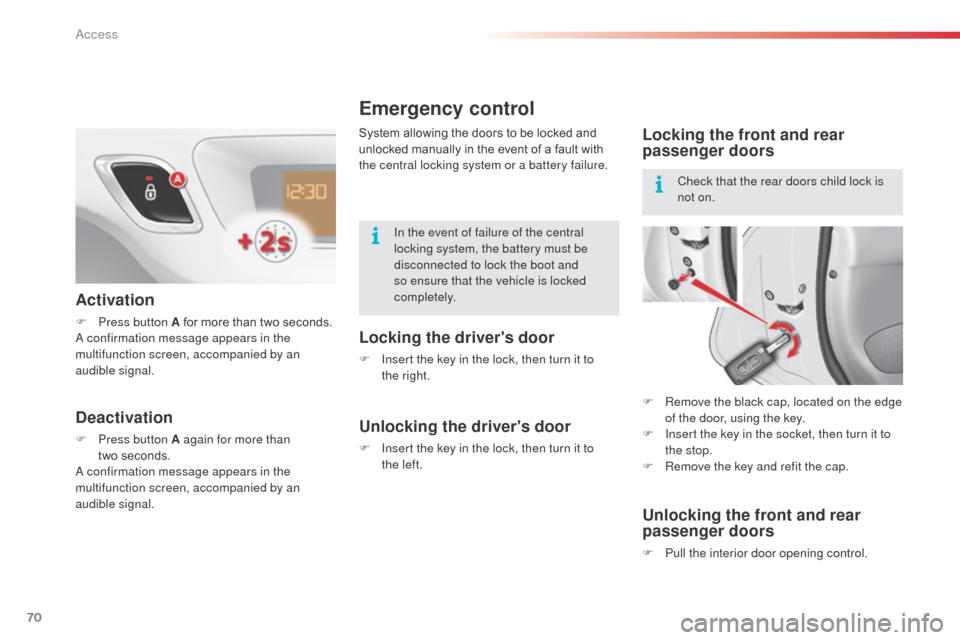
70
Emergency control
Locking the driver's door
F Insert the key in the lock, then turn it to the right.
Unlocking the driver's door
F Insert the key in the lock, then turn it to the left.
Locking the front and rear
passenger doors
F Remove the black cap, located on the edge of the door, using the key.
F
I
nsert the key in the socket, then turn it to
the stop.
F
R
emove the key and refit the cap.
Unlocking the front and rear
passenger doors
F Pull the interior door opening control.
In the event of failure of the central
locking system, the battery must be
disconnected to lock the boot and
so ensure that the vehicle is locked
completely.
Check that the rear doors child lock is
not on.
System allowing the doors to be locked and
unlocked manually in the event of a fault with
the central locking system or a battery failure.
Activation
F Press button A for more than two seconds.a
confirmation message appears in the
multifunction screen, accompanied by an
audible signal.
Deactivation
F Press button A again for more than two seconds.
a
confirmation message appears in the
multifunction screen, accompanied by an
audible signal.
Access
Page 73 of 401

71
boot
F after unlocking the vehicle, pull on the grip and raise the tailgate. F
L
ower the tailgate using the interior grab
handle.
-
w
hen the engine is running
,
this warning lamp comes on,
accompanied by a message on
the multifunction screen for a few
seconds,
Tailgate release
Unlocking
F Fold back the rear benchseat to gain access to the lock from inside the boot.
F
I
nsert a small screwdriver into hole A of the
lock to unlock the tailgate.
If the tailgate is not closed correctly:
Opening
Closing
- when the vehicle is moving (speed above
6 mph (10 km/h)), this warning lamp comes
on, accompanied by an audible signal and
a message on the multifunction screen for
a few seconds. System for mechanical unlocking of the boot
in the event of a battery or central locking
malfunction.
4
access
Page 74 of 401

72
Lighting controls
Main lighting
The various front and rear lamps of the vehicle
are designed to adapt the driver's visibility
progressively according to climatic conditions:
-
s
idelamps, to be seen,
-
d
ipped beam headlamps to see without
dazzling other drivers,
-
m
ain beam headlamps to see clearly when
the road is clear.
Additional lighting
other lamps are installed to fulfil the
requirements of particular conditions of
visibility:
-
a r
ear foglamp to be seen from afar,
-
f
ront foglamps for even better for ward
vision.
Programming
Various automatic lighting control modes
are also available according to the following
options:
-
gu
ide-me-home lighting,
-
a
utomatic illumination of headlamps.
Model without AUTO lighting
Model with AUTO lighting
Lighting off / daytime running
lam ps.
automatic illumination of headlamps.
Sidelamps only.
dip
ped or main beam headlamps.
B.
S
talk for switching the headlamp beam:
pull the stalk to switch between dipped and
main beam headlamps.
In the lamps off and sidelamps modes,
the
driver can switch on the main beam
headlamps temporarily ("headlamp flash") by
maintaining a pull on the stalk.
Displays
Lighting of the corresponding indicator lamp on
the instrument panel confirms the switching on
of the lighting selected.
dep
ending on version, the instrument panel
may have permanent back-lighting. Illumination
of the instrument panel is therefore not linked to
the exterior lighting.
Manual controls
The lighting is controlled directly by the driver
by means of the ring A and the stalk B .A.
M
ain lighting mode selection ring: turn it
to position the symbol required facing the
mark.
System for selection and control of the various front and rear lamps providing the vehicle's
lighting.
Visibility
Page 75 of 401
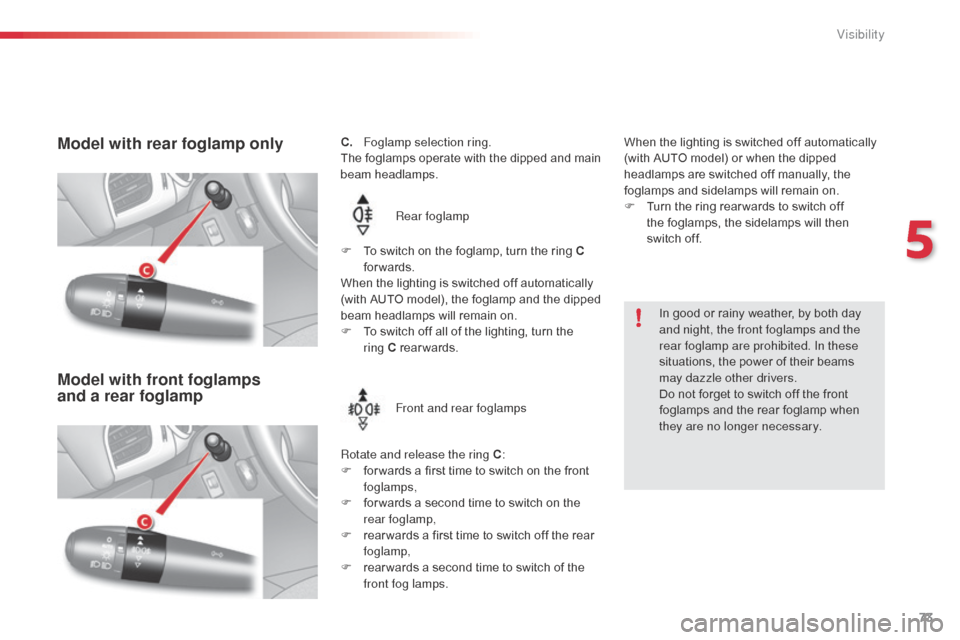
73
C. Foglamp selection ring.
The foglamps operate with the dipped and main
beam headlamps.Rear foglamp
Rotate and release the ring C :
F
f
or wards a first time to switch on the front
foglamps,
F
f
or wards a second time to switch on the
rear foglamp,
F
r
ear wards a first time to switch off the rear
foglamp,
F
r
ear wards a second time to switch of the
front fog lamps.Model with rear foglamp only
F To switch on the foglamp, turn the ring C forwards.
When the lighting is switched off automatically
(with AUTO model), the foglamp and the dipped
beam headlamps will remain on.
F
T
o switch off all of the lighting, turn the
ring
C rearwards.
Model with front foglamps
and a rear foglamp
Front and rear foglamps When the lighting is switched off automatically
(with AUTO model) or when the dipped
headlamps are switched off manually, the
foglamps and sidelamps will remain on.
F
T
urn the ring rear wards to switch off
the foglamps, the sidelamps will then
switch off.
In good or rainy weather, by both day
and night, the front foglamps and the
rear foglamp are prohibited. In these
situations, the power of their beams
may dazzle other drivers.
Do not forget to switch off the front
foglamps and the rear foglamp when
they are no longer necessary.
5
Visibility
Page 76 of 401

74
Manual guide-me-home
lighting
The temporary illumination of the dipped beam
headlamps after the vehicle's ignition has been
switched off makes the driver's exit easier
when the light is poor.
Switching on
F With the ignition off, "flash" the headlamps using the lighting stalk.
F
A f
urther "headlamp flash" switches the
function off.
Switching off
The manual guide-me-home lighting switches
off automatically after a set time.
In some weather conditions (e.g. low
temperature or humidity), the presence
of misting on the internal sur face of the
glass of the headlamps and rear lamps
is normal; it disappears after the lamps
have been on for a few minutes.
Lighting on audible warning
When the ignition is switched off, all
of the lamps switch off automatically,
unless guide-me-home lighting is
activated.
If the lighting is switched on manually
after switching off the ignition, there
is an audible signal when a front door
is opened to warn the driver that they
have forgotten to switch off the vehicle's
lighting, with the ignition off.
Visibility
Page 77 of 401
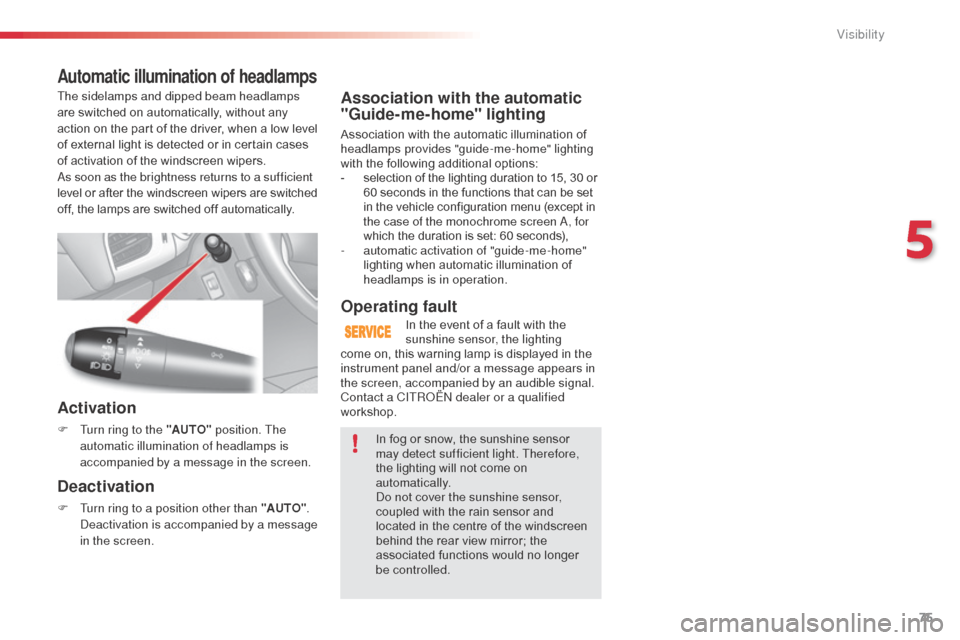
75
Association with the automatic
"Guide-me-home" lighting
Association with the automatic illumination of
headlamps provides "guide-me-home" lighting
with the following additional options:
-
s
election of the lighting duration to 15, 30 or
60 seconds in the functions that can be set
in the vehicle configuration menu (except in
the case of the monochrome screen
a
, f
or
which the duration is set: 60 seconds),
-
a
utomatic activation of "guide-me-home"
lighting when automatic illumination of
headlamps is in operation.
Operating fault
In the event of a fault with the
sunshine sensor, the lighting
come on, this warning lamp is displayed in the
instrument panel and/or a message appears in
the screen, accompanied by an audible signal.
Contact a CITR
oËn
dealer or a qualified
workshop.
In fog or snow, the sunshine sensor
may detect sufficient light. Therefore,
the lighting will not come on
automatically.
do n
ot cover the sunshine sensor,
coupled with the rain sensor and
located in the centre of the windscreen
behind the rear view mirror; the
associated functions would no longer
be controlled.
Automatic illumination of headlamps
Activation
F Turn ring to the "AUTO" position. The
automatic illumination of headlamps is
accompanied by a message in the screen.
Deactivation
F Turn ring to a position other than "AUTO" . de
activation is accompanied by a message
in the screen.
The sidelamps and dipped beam headlamps
are switched on automatically, without any
action on the part of the driver, when a low level
of external light is detected or in certain cases
of activation of the windscreen wipers.
as s
oon as the brightness returns to a sufficient
level or after the windscreen wipers are switched
off, the lamps are switched off automatically.
5
Visibility
Page 78 of 401
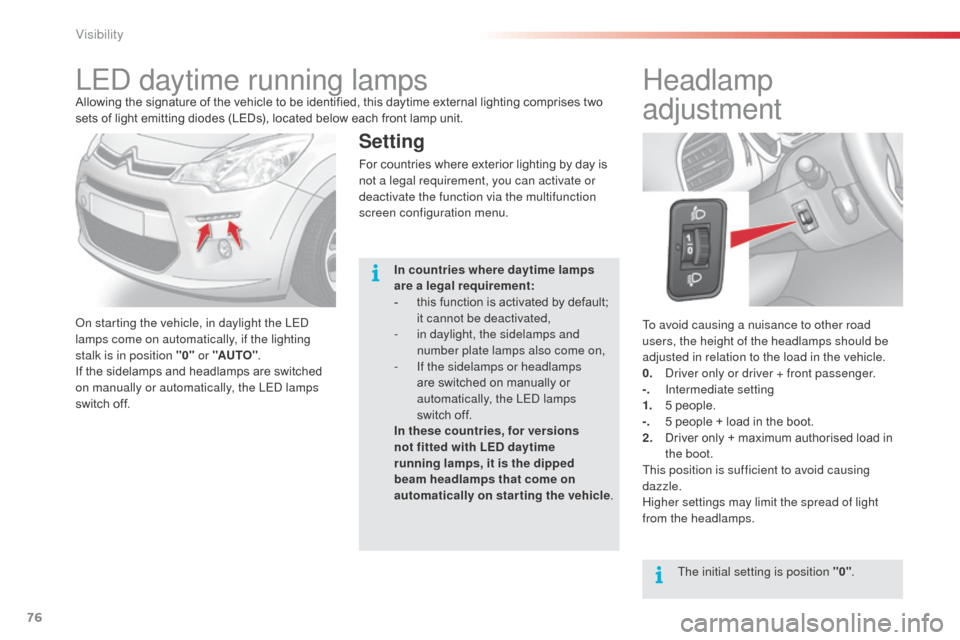
76
To avoid causing a nuisance to other road
users, the height of the headlamps should be
adjusted in relation to the load in the vehicle.
0. d
r
iver only or driver + front passenger.
-.
I
ntermediate setting
1.
5 p
eople.
-.
5 p
eople + load in the boot.
2.
D
river only + maximum authorised load in
the boot.
This position is sufficient to avoid causing
dazzle.
Higher settings may limit the spread of light
from the headlamps.
Headlamp
adjustment
The initial setting is position "0" .
LEd daytime running lampsAllowing the signature of the vehicle to be identified, this daytime external lighting comprises two
sets of light emitting diodes (LEDs), located below each front lamp unit.
on s
tarting the vehicle, in daylight the LE
d
lamps come on automatically, if the lighting
stalk is in position "0" or "AUTO".
If the sidelamps and headlamps are switched
on manually or automatically, the LE
d
lamps
switch off.
Setting
For countries where exterior lighting by day is
not a legal requirement, you can activate or
deactivate the function via the multifunction
screen configuration menu.
In countries where daytime lamps
are a legal requirement:
-
t
his function is activated by default;
it cannot be deactivated,
-
i
n daylight, the sidelamps and
number plate lamps also come on,
-
I
f the sidelamps or headlamps
are switched on manually or
automatically, the LE
d
lamps
switch off.
In these countries, for versions
not fitted with LED daytime
running lamps, it is the dipped
beam headlamps that come on
automatically on starting the vehicle .
Visibility
Page 79 of 401

77
Wiper controls
Programming
Various automatic wiper control modes are also
available according to the following options:
-
a
utomatic rain sensitive windscreen wipers,
-
r
ear wiping on engaging reverse gear.
Model with intermittent
wiping
Model with AUTO wipingThe vehicle's front and rear wipers are
designed to improve the driver's visibility
progressively according to the weather
conditions.Manual controls
Windscreen wipers
A. Wiping speed selection stalk.
Single wipe (press down and
release).
or Fast (heavy rain).
Normal (moderate rain).
Intermittent (proportional to the
speed of the vehicle).
of
f.Automatic, then single wipe
(see the corresponding
section).
The wiper commands are issued directly by the
driver by means of the stalk A and the ring B
.
5
Visibility
Page 80 of 401
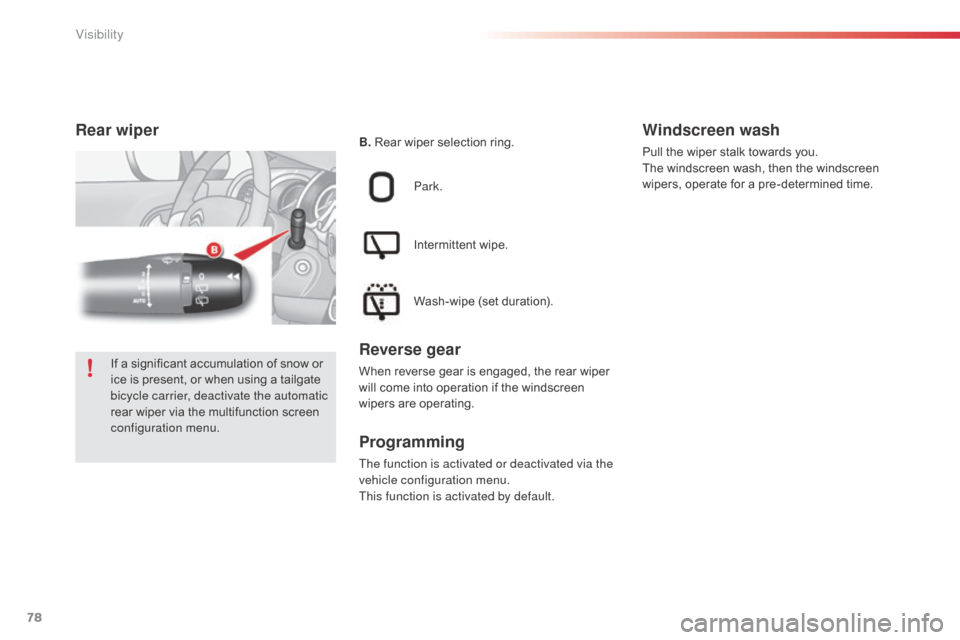
78
Rear wiper
Park.
Intermittent wipe.
Wash-wipe (set duration).
Reverse gear
When reverse gear is engaged, the rear wiper
will come into operation if the windscreen
wipers are operating.
Programming
The function is activated or deactivated via the
vehicle configuration menu.
This function is activated by default.
Windscreen wash
Pull the wiper stalk towards you.
The windscreen wash, then the windscreen
wipers, operate for a pre-determined time.
B.
Rear wiper selection ring.
If a significant accumulation of snow or
ice is present, or when using a tailgate
bicycle carrier, deactivate the automatic
rear wiper via the multifunction screen
configuration menu.
Visibility